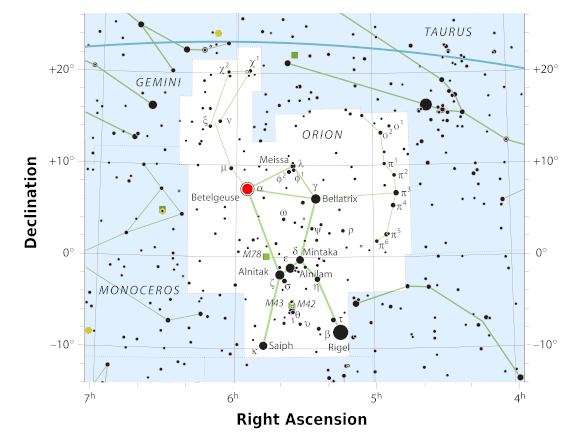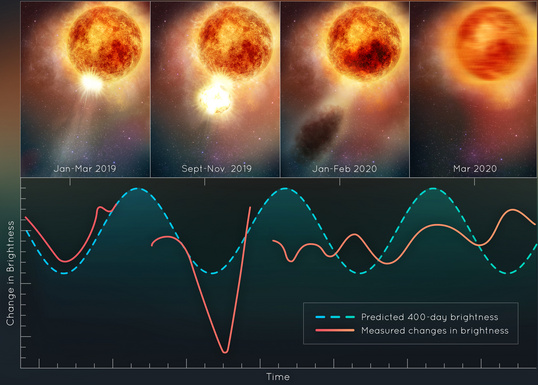
Boisterous Betelgeuse
October 31, 2022 We're lucky in having a nearby star, our Sun, for study. Our solar observations include detailed imaging of the Sun's surface that revealed the solar cycle of sunspots. Many space observatories have been launched for solar studies, and the European Space Agency's 2020 Solar Orbiter is presently in close orbit (as close as sixty solar radii) around the Sun, specifically for observations of its polar regions not visible from Earth. NASA's 2018 Parker Solar Probe for observations of the Sun's corona has a more aggressive orbit that takes it as close as ten solar radii. This space probe needs a carbon–carbon composite heat shield to protect it from an insolation that's 475 times that at the Earth, producing a temperature of about 1,370 °C (iron melts at 1538 °C).
Perhaps Judy Jetson became a television space weather weather girl.
The Sun's activity is not constant, so it has a variable affect on the Earth known as space weather.
A solar wind of particles will sometimes damage spacecraft electronics, disturb shortwave radio communication through disruption of the ionosphere, and cause electrical blackouts from induced currents in power transmission lines.
(GOES-16 solar ultraviolet image for September 5, 2022.[1] Click for larger image.)
Our Sun is a relatively normal star. Aside from the occasional coronal mass ejection, it remains in a relatively static state. This is quite unlike the somewhat near (548 light-years) star, Betelgeuse. This bright red giant star with about a 0.58 apparent magnitude in the Orion constellation has such an unusual name that it inspired the naming of the Netherworld character in the 1988 film, Beetlejuice (Tim Burton, director).[2] Betelgeuse, also called α-Orionis, is the next brightest star after Rigel in Orion, and it is usually the tenth-brightest star in the night sky. I use the term, usually, since Betelgeuse is a variable star with apparent visual magnitude ranging between 0.0 and 1.6. Apparent magnitude is scaled such that smaller numbers are brighter, and the scale is logarithmic based on the fifth root of 100; that is, a star with apparent magnitude one is a hundred times brighter than a star with magnitude six. Betelgeuse, however, is the brightest star in the night sky in the infrared. Betelgeuse has a surface temperature of 3590 K, compared with our Sun's 5,772 K, and a radius that's about 900 times the solar radius.

The Orion constellation with Betelgeuse shown in red, an appropriate color for a red giant star. The relative apparent magnitudes are illustrated by the size of the stars, and the right ascension in hours and the declination in degrees are shown. (Modified International Astronomical Union image via Wikimedia Commons. Click for larger image.)
There have been many indicators aside from its variable star nature that Betelgeuse is unstable. Angular size measurements starting in 1920 revealed an angular diameter ranging from 0.042 to 0.056 arcseconds. It also has a surrounding dust envelope cause by occasional mass ejection that's about 250 times its size. Things have recently become stranger. Betelgeuse started to noticeably dim in October, 2019; and, by the end of February, 2020, it had dimmed from magnitude 0.5 to 1.7, a factor of about three, only to increase in brightness to its normal range thereafter. Since infrared observations were fairly constant, it was concluded that the dimming was due to a change in opacity of the circumstellar dust and not a change in the luminosity of Betelgeuse, itself. A team of astronomers and astrophysicists has just published an analysis of this event in The Astrophysical Journal.[3-6] Using data from NASA's Hubble Space Telescope and other observatories, they concluded that Betelgeuse had a gigantic surface mass ejection in which it lost a substantial part of its surface, something that's never been seen in a normal star.[3-4] Team members are from the Harvard-Smithsonian Center for Astrophysics (Cambridge, Massachusetts), the Leibniz Institut für Astrophysik Potsdam (Potsdam, Germany), the American Association of Variable Star Observers (Cambridge, Massachusetts), the Max-Planck Institut for Extraterrestrial Physics (Garching, Germany), the Haystack Observatory of the Massachusetts Institute of Technology (Westford, Massachusetts), the Observatoire de Paris (Meudon, France), the Rutherford Appleton Laboratory (Harwell, United Kingdom), and the NASA Goddard Spaceflight Center (Greenbelt, Maryland).[3] Betelgeuse is classified as a supergiant since it has a diameter of about a billion miles. If it replaced our Sun, its outer surface would extend beyond the orbit of Jupiter.[4] Betelgeuse is an aging star near its life's end, and it will explode as a supernova that will be bright enough to be briefly visible at Earth in the daytime.[4] This won't happen for at least 100,000 years. One factor that assisted the analysis of the Betelgeuse dimming is that the star had been examined throughout the electromagnetic spectrum quite often before that time.[3] Our Sun routinely has mass ejections, but these coronal mass ejections are orders of magnitude weaker than what was seen on Betelgeuse.[4] The Betelgeuse surface mass ejection contained 400 billion times as much mass as a typical solar coronal mass ejection.[4] The likely cause of the Betelgeuse surface mass ejection was a convective plume, more than a million miles in size, emerging from deep inside the star.[4] This plume produced a shockwave that ejected a large portion of the photosphere.[4] As a result, the photosphere of Betelgeuse had a lower temperature, and its chromosphere had a lower density.[3-4]

Betelgeuse outburst, as imaged by the Hubble Space Telescope, 2019-2020. The star's dimming was a consequence of a titanic mass ejection of a large piece of its visible surface. The ejected material formed a cloud of dust that temporarily blocked the star's light. The blue curve shows the predicted light curve based on past observations, and the red curve shows the observed light output. (NASA, ESA, Elizabeth Wheatley (STScI) image, also available here. Click for larger image.)
Following its surface mass ejection, the regular 400 day optical and radial velocity periodicity of Betelgeuse observed by astronomers for 200 years, vanished, and it has not reappeared since.[3-4] This is likely a consequence of a disruption of the star's interior convection cells, which drive the regular pulsation.[4] The interior of Betelgeuse is likely ringing like a bell, and this is disrupting the star’s normal cycle, which is expected to reappear after a time.[4] These observations offer clues on the mass loss of such red supergiants late in their lives, before their supernova explosion. The amount of mass loss is an important factor in the timing of this event.[4] Says Andrea Dupree of the Harvard-Smithsonian Center for Astrophysics,
"We've never before seen a huge mass ejection of the surface of a star. We are left with something going on that we don't completely understand. It's a totally new phenomenon that we can observe directly and resolve surface details with Hubble. We're watching stellar evolution in real time."[4]
References:
- Space Weather Prediction Center, National Oceanic and Atmospheric Administration.
- Beetlejuice (1988, Tim Burton, director) on the Internet Movie Database.
- Andrea K. Dupree, Klaus G. Strassmeier, Thomas Calderwood, Thomas Granzer, Michael Weber, Kateryna Kravchenko, Lynn D. Matthews, Miguel Montarges, James Tappin, and William T. Thompson, "The Great Dimming of Betelgeuse: a Surface Mass Ejection (SME) and its Consequences," The Astrophysical Journal, vol. 936, no. 1 (August 25, 2022). Also at arXiv.
- Hubble Sees Red Supergiant Star Betelgeuse Slowly Recovering After Blowing Its Top, Hubble Space Telescope press release 2022-037, August 11, 2022.
- Hubble Sees Red Supergiant Star Betelgeuse Slowly Recovering after Blowing its Top, Harvard-Smithsonian Center for Astrophysics press release, August 11, 2022.
- Hubble Sees Red Supergiant Star Betelgeuse Slowly Recovering After Blowing Its Top, NASA press release, August 11, 2022.